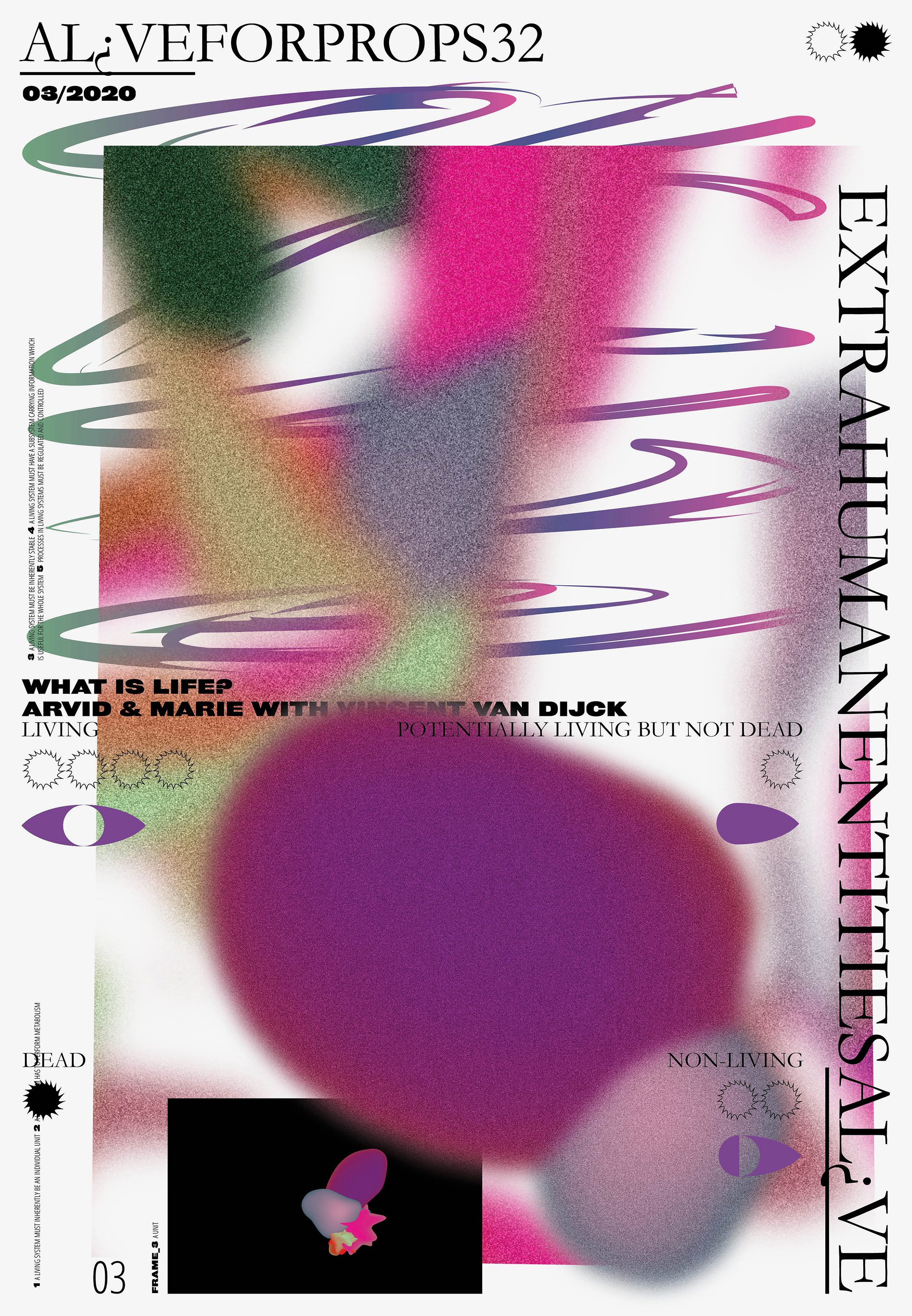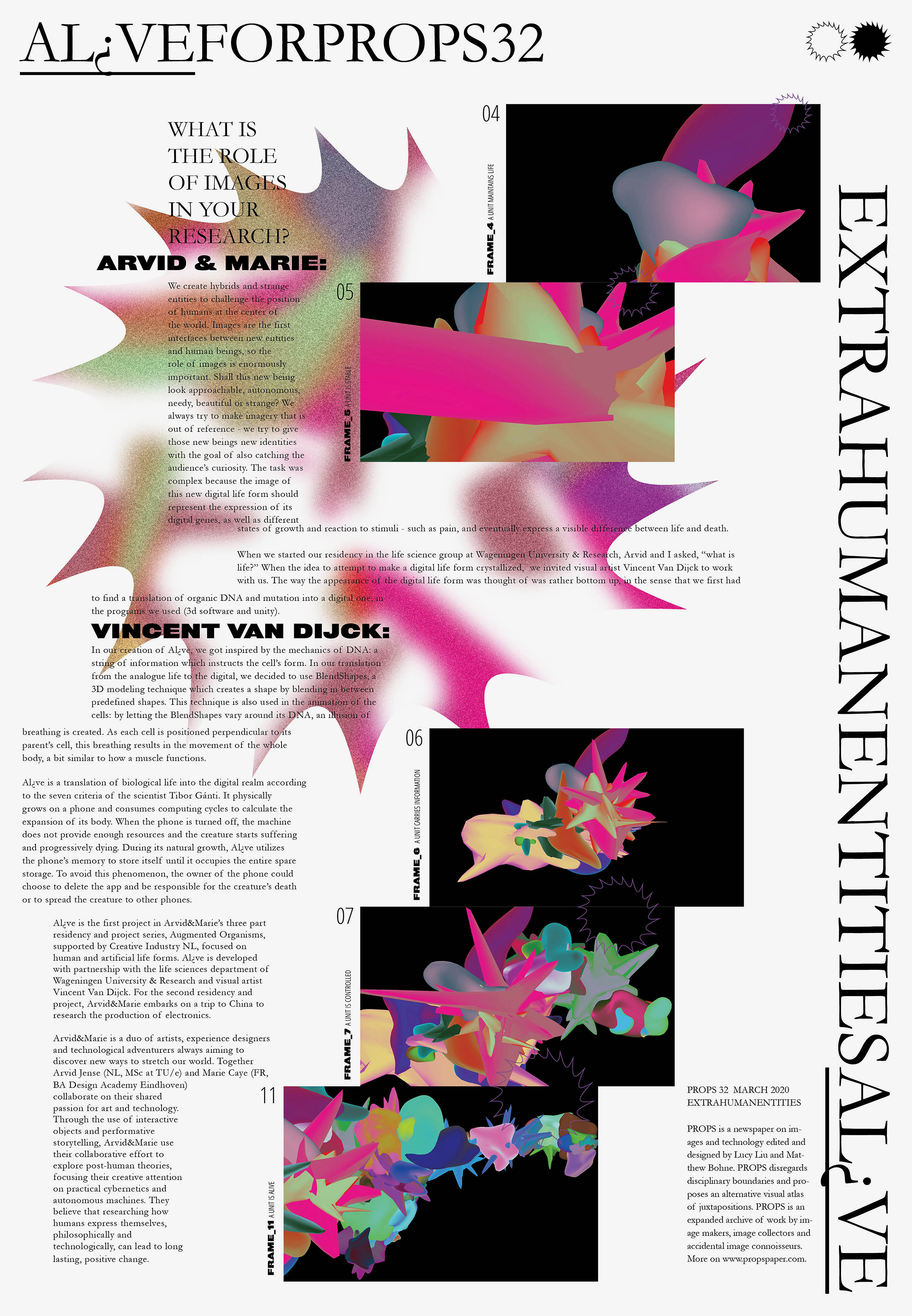

32 AL¿VE
ARVID&MARIE︎︎︎
Images are the first interfaces between new entities and human beings, so the role of images is enormously important. Shall this new being look approachable, autonomous, needy, beautiful or strange? We always try to make imagery that is out of reference — we try to give those new beings new identities with the goal of also catching the audience's curiosity. The task was complex because the image of this new digital life form should represent the expression of its digital genes, as well as different states of growth and reaction to stimuli — such as pain, and eventually express a visible difference between life and death.
When we started our residency in the life science group at Wageningen University & Research, Arvid and I asked, "what is life?” When the idea to attempt to make a digital life form crystallized, we invited visual artist Vincent Van Dijck to work with us. The way the appearance of the digital life form was thought of was rather bottom up, in the sense that we first had to find a translation of organic DNA and mutation into a digital one, in 3d software and UNITY.
Vincent Van Dijck ︎︎︎
In our creation of Al¿ve, we got inspired by the mechanics of DNA: a string of information which instructs the cell's form. In our translation from the analogue life to the digital, we decided to use BlendShapes, a 3D modeling technique which creates a shape by![]() . This technique is also used in the animation of the cells: by letting the BlendShapes vary around its DNA, an illusion of breathing is created. As each cell is positioned perpendicular to its parent's cell, this breathing results in the movement of the whole body, a bit similar to how a muscle functions.
. This technique is also used in the animation of the cells: by letting the BlendShapes vary around its DNA, an illusion of breathing is created. As each cell is positioned perpendicular to its parent's cell, this breathing results in the movement of the whole body, a bit similar to how a muscle functions.
Al¿ve is a translation of biological life into the digital realm according to the seven criteria of the scientist Tibor Gánti. It physically grows on a phone and consumes computing cycles to calculate the expansion of its body. When the phone is turned off, the machine does not provide enough resources and the creature starts suffering and progressively dying. During its natural growth, Al¿ve utilizes the phone’s memory to store itself until it occupies the entire spare storage. To avoid this phenomenon, the owner of the phone could choose to delete the app and be responsible for the creature’s death or to spread the creature to other phones.
Arvid&Marie ︎︎︎ is a duo of artists, experience designers and technological adventurers always aiming to discover new ways to stretch our world. Together Arvid Jense (NL, MSc at TU/e) and Marie Caye (FR, BA Design Academy Eindhoven) collaborate on their shared passion for art and technology. Through the use of interactive objects and performative storytelling, Arvid&Marie use their collaborative effort to explore post-human theories, focusing their creative attention on practical cybernetics and autonomous machines. They believe that researching how humans express themselves, philosophically and technologically, can lead to long lasting, positive change.
AL¿VE is the first project in Arvid&Marie’s three part residency and project series, Augmented Organisms, supported by Creative Industry NL, focused on human and artificial life forms. AL¿VE is developed with partnership with the life sciences department of Wageningen University & Research and visual artist Vincent Van Dijck.
Images are the first interfaces between new entities and human beings, so the role of images is enormously important. Shall this new being look approachable, autonomous, needy, beautiful or strange? We always try to make imagery that is out of reference — we try to give those new beings new identities with the goal of also catching the audience's curiosity. The task was complex because the image of this new digital life form should represent the expression of its digital genes, as well as different states of growth and reaction to stimuli — such as pain, and eventually express a visible difference between life and death.
When we started our residency in the life science group at Wageningen University & Research, Arvid and I asked, "what is life?” When the idea to attempt to make a digital life form crystallized, we invited visual artist Vincent Van Dijck to work with us. The way the appearance of the digital life form was thought of was rather bottom up, in the sense that we first had to find a translation of organic DNA and mutation into a digital one, in 3d software and UNITY.
Vincent Van Dijck ︎︎︎
In our creation of Al¿ve, we got inspired by the mechanics of DNA: a string of information which instructs the cell's form. In our translation from the analogue life to the digital, we decided to use BlendShapes, a 3D modeling technique which creates a shape by
blending in between predefined shapes

Al¿ve is a translation of biological life into the digital realm according to the seven criteria of the scientist Tibor Gánti. It physically grows on a phone and consumes computing cycles to calculate the expansion of its body. When the phone is turned off, the machine does not provide enough resources and the creature starts suffering and progressively dying. During its natural growth, Al¿ve utilizes the phone’s memory to store itself until it occupies the entire spare storage. To avoid this phenomenon, the owner of the phone could choose to delete the app and be responsible for the creature’s death or to spread the creature to other phones.
Arvid&Marie ︎︎︎ is a duo of artists, experience designers and technological adventurers always aiming to discover new ways to stretch our world. Together Arvid Jense (NL, MSc at TU/e) and Marie Caye (FR, BA Design Academy Eindhoven) collaborate on their shared passion for art and technology. Through the use of interactive objects and performative storytelling, Arvid&Marie use their collaborative effort to explore post-human theories, focusing their creative attention on practical cybernetics and autonomous machines. They believe that researching how humans express themselves, philosophically and technologically, can lead to long lasting, positive change.
AL¿VE is the first project in Arvid&Marie’s three part residency and project series, Augmented Organisms, supported by Creative Industry NL, focused on human and artificial life forms. AL¿VE is developed with partnership with the life sciences department of Wageningen University & Research and visual artist Vincent Van Dijck.